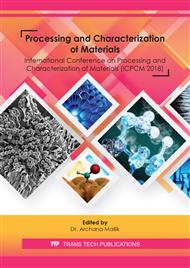[1]
D.R. Bortz, C. Merino, I. Martin-Gullon, Carbon nanofibers enhance the fracture toughness and fatigue performance of a structural epoxy system, Composites Science and Technology. 71 (2011) 31–38.
DOI: 10.1016/j.compscitech.2010.09.015
Google Scholar
[2]
Y. Zhou, F. Pervin, V.K. Rangari, S. Jeelani, Fabrication and evaluation of carbon nano fiber filled carbon/epoxy composite, Materials Science and Engineering: A. 426 (2006) 221–228.
DOI: 10.1016/j.msea.2006.04.031
Google Scholar
[3]
M.J. Palmeri, K.W. Putz, T. Ramanathan, L.C. Brinson, Multi-scale reinforcement of CFRPs using carbon nanofibers, Composites Science and Technology. 71 (2011) 79–86.
DOI: 10.1016/j.compscitech.2010.10.006
Google Scholar
[4]
R.K. Prusty, S.K. Ghosh, D.K. Rathore, B.C. Ray, Reinforcement effect of graphene oxide in glass fibre/epoxy composites at in-situ elevated temperature environments: An emphasis on graphene oxide content, Composites Part A: Applied Science and Manufacturing. 95 (2017) 40–53.
DOI: 10.1016/j.compositesa.2017.01.001
Google Scholar
[5]
R.K. Prusty, D.K. Rathore, B.C. Ray, CNT/polymer interface in polymeric composites and its sensitivity study at different environments, Advances in Colloid and Interface Science. 240 (2017) 77–106.
DOI: 10.1016/j.cis.2016.12.008
Google Scholar
[6]
R.K. Prusty, D.K. Rathore, B.C. Ray, Evaluation of the role of functionalized CNT in glass fiber/epoxy composite at above- and sub-zero temperatures: Emphasizing interfacial microstructures, Composites Part A: Applied Science and Manufacturing. 101 (2017) 215–226.
DOI: 10.1016/j.compositesa.2017.06.020
Google Scholar
[7]
R.K. Prusty, D.K. Rathore, M.J. Shukla, B.C. Ray, Flexural behaviour of CNT-filled glass/epoxy composites in an in-situ environment emphasizing temperature variation, Composites Part B: Engineering. 83 (2015) 166–174.
DOI: 10.1016/j.compositesb.2015.08.035
Google Scholar
[8]
T. Natsuki, Q.-Q. Ni, S.-H. Wu, Temperature dependence of electrical resistivity in carbon nanofiber/unsaturated polyester nanocomposites, Polym Eng Sci. 48 (2008) 1345–1350.
DOI: 10.1002/pen.21108
Google Scholar
[9]
C.J. Huang, S.Y. Fu, Y.H. Zhang, B. Lauke, L.F. Li, L. Ye, Cryogenic properties of SiO2/epoxy nanocomposites, Cryogenics. 45 (2005) 450–454.
DOI: 10.1016/j.cryogenics.2005.03.003
Google Scholar
[10]
Y.C. Zhang, X. Wang, Hygrothermal Effects on Interfacial Stress Transfer Characteristics of Carbon Nanotubes-reinforced Composites System, Jnl of Reinforced Plast and Composites. 25 (2006) 71–88.
DOI: 10.1177/0731684406055456
Google Scholar
[11]
J. Suhr, W. Zhang, P.M. Ajayan, N.A. Koratkar, Temperature-Activated Interfacial Friction Damping in Carbon Nanotube Polymer Composites, Nano Lett. 6 (2006) 219–223.
DOI: 10.1021/nl0521524
Google Scholar
[12]
G. Tsagaropoulos, A. Eisenberg, Dynamic mechanical study of the factors affecting the two glass transition behavior of filled polymers. Similarities and differences with random ionomers, Macromolecules. 28 (1995) 6067–6077.
DOI: 10.1021/ma00122a011
Google Scholar


